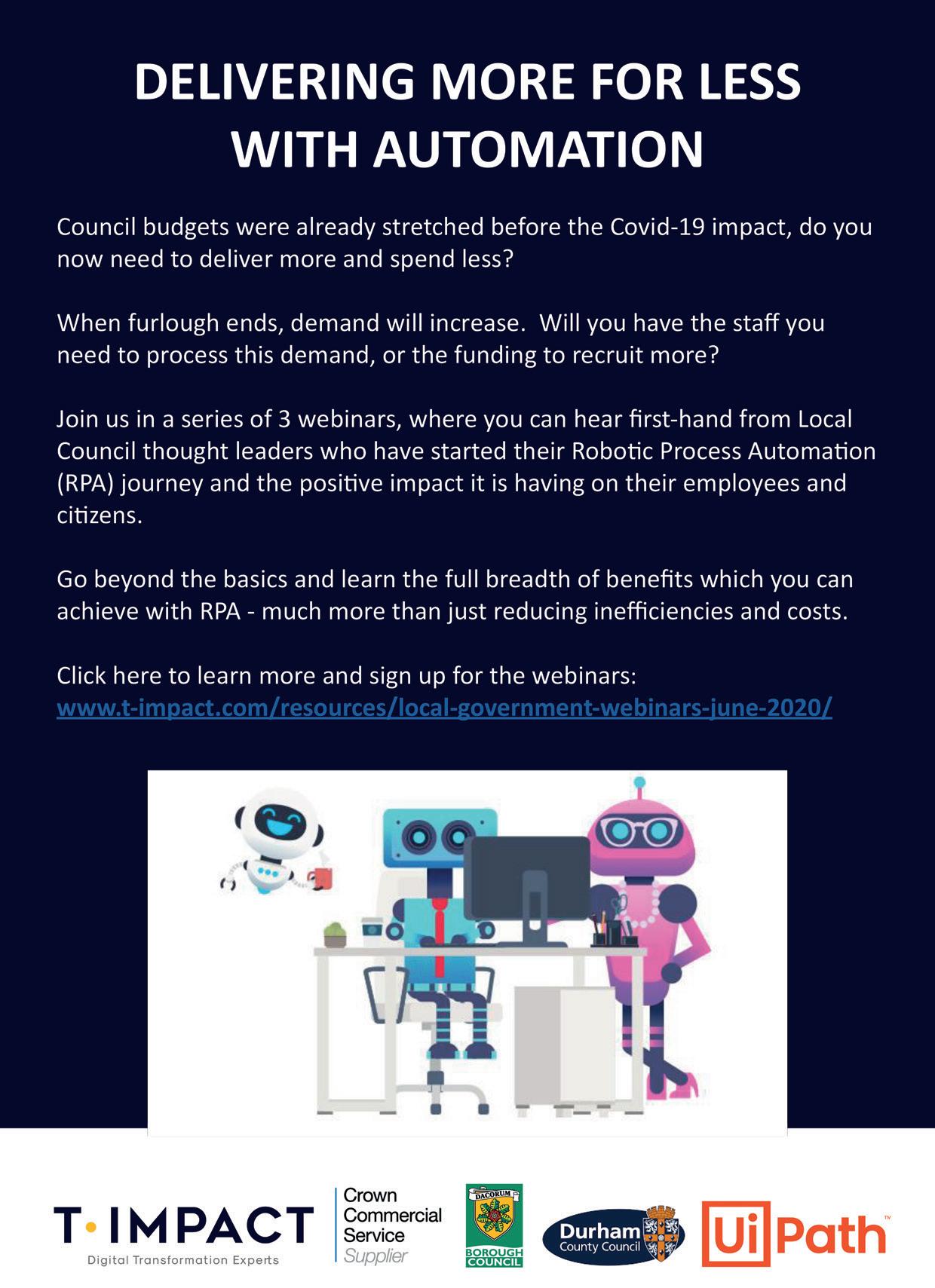
5 minute read
Digital is now clearly front and centre for councils
Georgina Maratheftis, of techUK, explains how tech innovation can help authorities with the most pressing problems that they and their communities face
The Covid-19 crisis has been a catalyst of digital change for many local authorities. From increases in remote working to virtual committee meetings to how services are being delivered, councils are working digitally. Technology is the easy part. Transformation and innovation itself, however, is an ongoing process and in this piece we outline some of the steps councils can take to make it sustainable.
Leadership
Culture and leadership are key to creating the environment to enable successful transformation. Councils must understand the digital components within their organisation at the executive level so that the leadership can recognise how public services can be transformed. Digital is no longer just the responsibility of IT – it is everyone’s. The vision needs to come from the top and any digital strategy needs to sit alongside a council-wide organisational strategy. People and agencies need to feel confident and empowered to break down silos and innovate.

While all councils’ adoption of digital has moved at pace during the crisis, those councils that already had strong leadership, strong existing digital infrastructure and agility were able to respond swiftly. This was highlighted in techUK’s communities and public services post-covid webinar where Paul Brewer, Director for Digital and Resources at Adur and Worthing Councils, described how they utilised existing digital platforms to understand demand and design a service within 48 hours to manage referrals across voluntary organisations, ensuring much needed community support.
Challenge-led innovation
When embarking on any transformation, councils should start with the problem they are trying to solve and the outcome they want to achieve. This means focused on what the users need rather than what products/solutions are available. One of the essential ways to achieve this is by bringing local public services and the tech industry together early in the procurement system to interrogate what the challenge is, understand the art of the possible, and validate ideas. From the GovTech Catalyst Challenge to TechForce19, we are seeing the growth of challenge innovation funds which is encouraging and provides a useful vehicle for SMEs and new entrants to also access the market.

Advertisement
Place-based innovation
Transformation and innovation done well targets specific problems in specific localities and improve the lives of people and their communities. Local government must empower people and take a place-based approach to digital projects. The current crisis has illustrated the importance of collaboration at the local level and marked a firm shift to place-based working where departments and agencies are all looking at digital responses to specific local challenges.
Place-based approaches are not new. With local public services continuing to face financial constraints and rising demand, there is recognition that challenges are increasingly interlinked and cannot be faced by individual service providers. An excellent example of this is Wigan’s award-winning ‘The Deal’, an informal agreement between the council and everyone who lives or works in Wigan to work together to create a better borough. It aims to use technology to facilitate the delivery of integrated services with communities at the heart of service delivery.

Elsewhere, in Greater Manchester, a brand new ‘early warning’ system for its care homes has been drawn up in the space of a week. This has seen the region’s ten councils share a dashboard of information on which homes are reporting problems, so that other parts of the system can step in to help. Microsoft has been working with Greater Manchester Combined Authority to develop a mobile application to support Community Hubs providing services to vulnerable people. There are many more examples of this, illustrated with the numbers of offers from the tech industry in response to techUK’s Covid-19 local government repository.
Council of the future
We have seen how quickly councils can digitise during the pandemic. Councils and industry, together, should look at what has been done well and take these learnings forward. In techUK’s Council of the Future: a digital guide for Councillors, we explored how truly digital councils will be more connected and integrated, with citizens and communities being the drivers of those changes.
Getting to this vision is no easy feat but the crisis has shown that the leadership and capability is there. Data is at the heart of decision-making and helping tackle cross-cutting challenges. As we move forward, we must continue the engagement between industry and local government organisations and bring together all these ingredients to drive meaningful transformation for citizens and our communities. As we look to what the future of digital local public services look like, we urge you to get in touch to share what you think this could look like. There’s never been a more important time to collaborate.
FURTHER INFORMATION: www.techuk.org
Councils lacking a consistent view of cyber security
New government research has found inconsistencies across local authorities in England as to what cyber security is as well as its threat to their organisations. Having interviewed 163 local authorities across England on ransomware, the Ministry of Housing, Communities and Local Government report sought to identify how central government can reduce risk and optimise spending in support of, and collaboration with, local authorities.
However, responding authorities had difficulty providing uniform definitions of what constitutes a breach, despite 37 attempted breaches of UK local authorities occurring every minute.
Although the National Cyber Security Strategy includes information management as part of its cyber security definition, stakeholders quoted in the research felt that information management is separate to cyber security, whilst also expressing the view that cyber security and risk related solely to penetration testing, defending against hackers and defending against virus threats.
The report says that this forms an ‘incomplete perspective’ as it excludes cyber risk extending to the systems, the data kept in the systems, the hardware used to access the systems and the services provided.
Cyber security was also viewed by the majority as a technical issue, rather than a business responsibility.
https://bit.ly/2XODgIn










